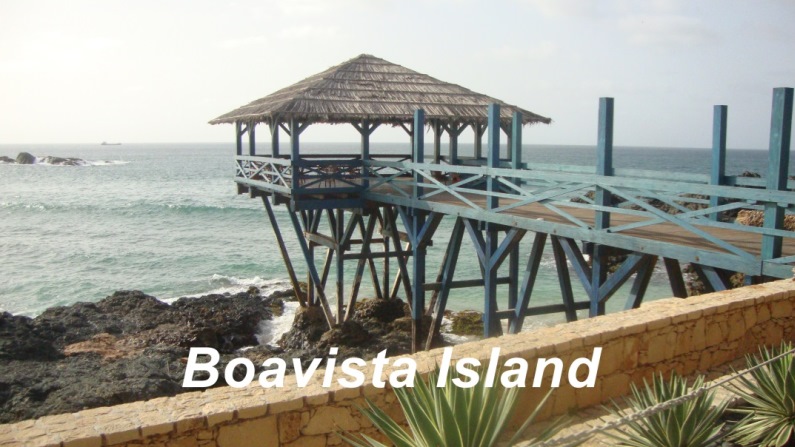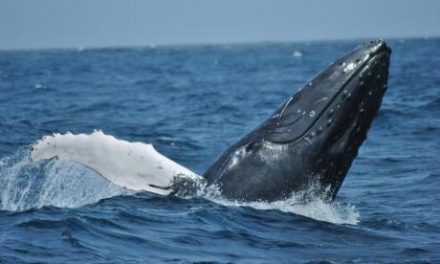A blog by Gennaro Cascella:

I have been living and working on the island of Boa Vista, Cape Verde for a number of years. I worked mainly as a Tour Guide on a sailing catamaran which takes tourists out to observe the Whales from March to late May. I have been fortunate to assist in carrying out research with conservation organisations including several international organizations such as IWDG, WWF, NOAA, and others.
It is not recommended for individual members of the public to just jump in off a boat to see Whales under the water, I explain why further down the page.
However, having worked with a number of experts in watching whale behaviour I felt that if I could get permission I would like to get in the ocean and swim with a humpback whale this year. This was my chance as there it was, floating without moving, really close to the vessel.
I first asked permission from the Capitan of the vessel and then also the Marine Biologist on board, Professor Pedro Lopez. I was told that due to my experience and the whale’s behaviour, it would be safe for me to enter the water. I was feeling a mixture of nerves and excitement.
So with heart beating quickly with the huge whale behind the catamaran I got undressed and grabbed a face mask, then lay down on the lower part of the catamaran (which is on the back where the stairs to help swimmers to come aboard are located).
Grabbing the handrails, belly down, face to the sea, I could clearly see the whale, sometimes exhaling close to the surface and sometimes diving just for a few meters. As I lay there, face in the water, it was like being on a roller-coaster except that my roller-coaster was going in and out of the water.
When I felt comfortable enough, I pushed with my legs and tried to slip as smoothly as possible away from the boat and into the deep blue. Then i saw it. From the depth of the not-so-clear waters of the Sal Rei bay I saw the big pectoral fins of the whale, which are white as porcelain, getting closer, and then the whole whale shape became clearer. I really wanted to make eye-contact with the whale.
So at last, we meet each other, eye to eye, studying each other and asking ourselves who and why and what and so many thoughts which, in me, blend into confusion which became then absolute inner peace. The whale looks relaxed and not intending to move any further. Then I was overwhelmed and I realized where I was (my biggest fear is the deep blue). Suddenly I became freaky scared, but at the same time so excited knowing that such an experience would change my life. I continued observing the whale lying just a few meters below me, he looked so calm. Then I felt like an iron hand squeeze my throat so I came up to breathe, but that was difficult, the adrenaline was just too much. I started to panic so I swam back to the catamaran and climbed on board. I had done it, I had seen and experienced something so magnificant.
For the rest of the afternoon I lay down in a corner with my eyes closed and tried to visualize in my mind what was now the best 30 minutes of my life.
The whale is probably a male; which was named Gégé (my nickname) in the catalogue that we are building here (eastern north Atlantic humpback whales). In Cape Verde we have just a small population of Whales (300 individuals) which are highly endangered due to the small population size and the poor recovery after whaling was stopped. Before whaling there where more than 5000 humpback whales in the whole of the Cape Verdean Archipelago! So it is really important that there is conservation and protection for such magnificent animals, so that generations after us, people will be able to enjoy environment and will have a better understanding of what is around us in the ocean. The oceans cover more than the 70% of our planet and little is known about them.
I feel so happy and so honoured to have such a meeting, I was really lucky, even if you need lots of cold blood to dive with a 12 meters whale, I think i was more lucky than brave!
NOTE:
People which come whale watching are not permitted to dive with the wales.
1. Because you need to be really confident with free diving, hold your breath and with swimming.
2. It can be quite dangerous to get close to the whale, not because they are aggressive (humpback whales are not predators, they feed on shoaling fishes like sardines and herrings) or because they size (fully grown they can reach the 15 m per 40 T) but because the bad visibility of the water here in boa vista
3. There many other reasons (you should find the right situation, the right whale and the right weather condition. it would be really difficult to dive with six males fighting to get a mate, or with two individuals which are fast swimming or with a whale breaching off the water).
4. So, the conclusion is that to swim with a whale you should be really lucky but also have spent enough time with the whales to know them, love them and respect them.
More info: http://www.facebook.com/l/LAQEtLX-0AQGHeFIWjmmvgN-m7Dp-SMxEUXWAlLGcROlgpg/www.naturaliaecotours.com







